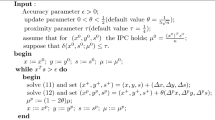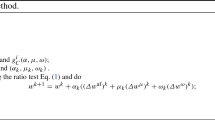Abstract
We study, in the context of interior-point methods for linear programming, some possible advantages of postponing the choice of the penalty parameter and the steplength, which happens both when we apply Newton's method to the Karush-Kuhn-Tucker system and when we apply a predictor-corrector scheme. We show that for a Newton or a strictly predictor step the next iterate can be expressed as a linear function of the penalty parameter μ, and, in the case of a predictor-corrector step, as a quadratic function of μ. We also show that this parameterization is useful to guarantee either the non-negativity of the next iterate or the proximity to the central path. Initial computational results of these strategies are shown and compared with PCx, an implementation of Mehotra's predictor-corrector method.
Similar content being viewed by others
References
D.A. Bayer and J.C. Lagarias, “The nonlinear geometry of linear programming. I: Affine and projective scaling trajectories. II: Legendre transform coordinates and central trajectories,” Transactions of the American Mathematical Society, vol. 314, pp. 499–581, 1989.
T.J. Carpenter, I.J. Lustig, and D.F Shanno, “Higher-order predictor-corrector interior point methods with application to quadratic objectives,” SIAM Journal of Optimization, vol. 3, pp. 696–725, 1993.
J. Czyzyk, S. Mehrotra, M. Wagner, and S.J. Wright, PCx User Guide (Version 1.1). Optimization Technology Center, 1997.
A.V. Fiacco and G.P. McCormick, Nonlinear Programming: Sequential Unconstrained Minimization Techniques, JohnWiley & Sons: New York, 1968 (Reprint: SIAM Classics in Applied Mathematics, vol. 4, SIAM Publications: Philadelphia, 1990).
K.R. Frisch, “The logarithmic potential method for convex programming,” Unpublished manuscript, Institute of Economics, University of Oslo, Oslo, Norway, May 1955.
P.E. Gill, W. Murray, M.A. Saunders, J.A. Tomlin, and M.H. Wright, “On projected Newton barrier methods for linear programming and an equivalence to Karmakar's projective method,” Mathematical Programming, vol. 36, pp. 183–209, 1986.
A.J. Goldman and A.W. Tucker, “Polyedral convex cones,” in Linear Inequalities and Related Systems, H.W. Kuhn and A.W. Tucker (Eds.), Princeton University Press: Princeton, NJ, 1956, pp. 19–40.
J. Gondzio, “Multiple centrality corrections in a primal-dual method for linear programming,” Computational Optimization and Applications, vol. 6, pp. 137–156, 1996.
P. Hung and Y. Ye, “An asymptotical \(\mathcal{O}(\sqrt n L)\)-iteration path-following linear programming algorithm that uses wide neighbourhoods,” SIAM Journal of Optimization, vol. 6, pp. 570–586, 1996.
B. Jansen, C. Roos, T. Terlaky, and J.-Ph. Vial, “Primal-dual algorithms for linear programming based on the logarithmic barrier methods,” Journal of Optimization Theory and Applications, vol. 83, pp. 1–26, 1994.
M. Kojima, S. Mizuno, and A. Yoshise, “A polynonial-time algorithm for a class of linear complementarity problems,” Mathematical Programming, vol. 44, pp. 1–26, 1989.
M. Kojima, S. Mizuno, and A. Yoshise, “A primal-dual interior point algorithm for linear programming,” in Progress in Mathematical Programming: Interior Point and Related Methods, N. Megiddo (Ed.), Springer Verlag: New York, 1989, pp. 29–47.
N. Megiddo, “Pathways to the optimal set in linear programming,” in Progress in Mathematical Programming: Interior Point and Related Methods, N. Megiddo (Ed.), Springer Verlag: New York, 1989, pp. 131–158 (Identical version in: Proceedings of the 6th Mathematical Programming Symposium of Japan, Nagoya, Japan, 1986, pp. 1-35).
S. Mehrotra, “On the implementation of a primal-dual interior point method,” SIAM Journal on Optimization, vol. 2, no. 4, pp. 575–601, 1992.
R. Monteiro, I. Adler, and M. Resende, “A polynomial-time primal-dual affine scaling algorithm for linear and convex quadratic programming and it's power series extension,” Mathematics of Operations Research, vol. 15, no. 2, pp. 191–213, 1990.
R.D.C. Monteiro and I. Adler, “Interior path following primal-dual algorithms: Part I: Linear programming,” Mathematical Programming, vol. 44, pp. 27–41, 1989.
E. Ng and B.W. Peyton, “Block sparse Cholesky algorithms on advanced uniprocessor computers,” SIAM Journal on Scientific Computing, vol. 14, pp. 1034–1056, 1993.
J. Peng, C. Roos, and T. Terlaky, “A new class of polynomial primal-dual methods for linear and semidefinite optimization,” Technical report, Faculty of Information Technology and Systems, Delft University of Technology, December 1999.
J. Peng, C. Roos, and T. Terlaky, “New complexity analysis of the primal-dual Newton method for linear optimization,” Annals of Operations Research, vol. 99, nos. 1–4, pp. 23–39, 2000.
G. Sonnevend, “An ‘analytic center’ for polyhedrons and new classes of global algorithms for linear (smooth, convex) programming,” in System Modelling and Optimization: Proceedings of the 12th IFIP-Conference held in Budapest, Hungary, September 1985, A. Prekopa, J. Szelezsan, and B. Strazicky (Eds.), Lecture Notes in Control and Information Sciences, vol. 84, Springer Verlag: Berlin, West-Germany, 1986, pp. 866–876.
A.W. Tucker, “Dual systems of homogeneous linear relations,” in Linear Inequalities and Related Systems, H.W. Kuhn and A.W. Tucker (Eds.), Princeton University Press: Princeton, NJ, 1956, pp. 3–18.
X. Xu, “An \(\mathcal{O}(\sqrt n L)\)-iteration large-step infeasible path-following algorithm for linear programming,” Technical report, Department of Management Sciences, The University of Iowa, Iowa City, Iowa 52242, USA, 1994.
X. Xu, P. Hung, and Y. Ye, “A simplification of the homogeneous and self-dual linear programming algorithm and its implementation,” Annals of Operations Research, vol. 62, pp. 151–172, 1996.
X. Xu and Y. Ye, “A generalized homogeneous and self-dual algorithm for linear programming,” Operations Research Letters, vol. 17, no. 4, pp. 181–190, 1995.
Y. Ye, M.J. Todd, and S. Mizuno, “An \(\mathcal{O}(\sqrt n L)\)-iteration homogeneous and self-dual linear programming algorithm,” Mathematics of Operations Research, vol. 19, pp. 53–67, 1994.
Yinyu Ye, Interior Point Algorithms: Theory and Analysis, John Wiley and Sons, New York, 1997.
Y. Zhang and D. Zhang, “On polynomiality of the mehotra-type predictor-corrector interior-point algorithms,” Mathematical Programming, vol. 68, pp. 303–318, 1995.
Author information
Authors and Affiliations
Rights and permissions
About this article
Cite this article
Villas-Bôas, F.R., Perin, C. Postponing the Choice of Penalty Parameter and Step Length. Computational Optimization and Applications 24, 63–81 (2003). https://doi.org/10.1023/A:1021850032714
Issue Date:
DOI: https://doi.org/10.1023/A:1021850032714




